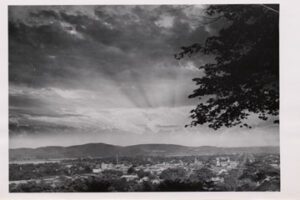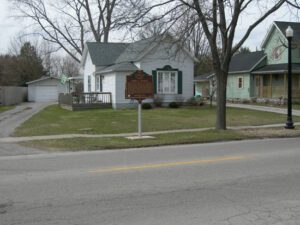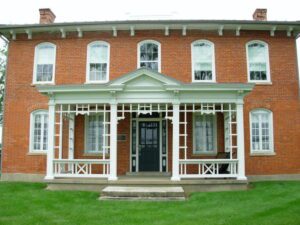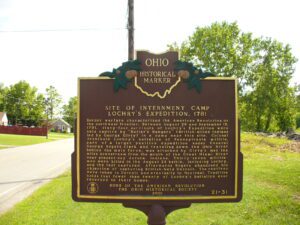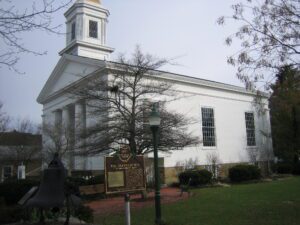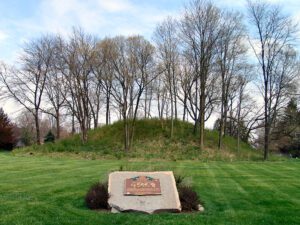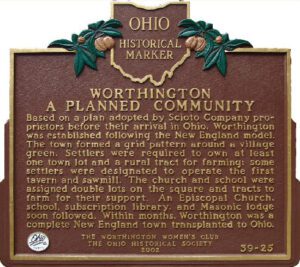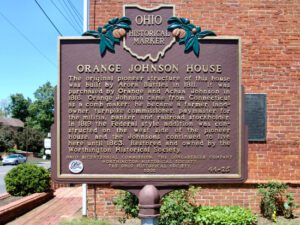, OH
The hills before you were inspiration for the design of The Great Seal of the State of Ohio. The seal, first depicted in 1803, was often reconfigured until the present image was sanctioned by the Ohio General Assembly in 1967 and modified in 1996. In 1803 the law prescribed the sheaf of wheat to represent Ohio’s agricultural roots and the bundle of seventeen arrows to symbolize Ohio’s place as the seventeenth state in the Union. In the background is a range of hills, including Mount Logan, as viewed from Thomas Worthington’s estate, Adena, now a state memorial. (continued from other side)
, OH
Born July 25, 1832, near Worthington, Ohio, John Alf Wilson lived at this site. At the age of 29, he enlisted in C. Company, 21st Ohio Volunteer Infantry under General O.M. Mitchell. General Mitchell consented to a dangerous mission led by John Andrews to cripple Confederate supply lines. Alf Wilson was one of 22 men who volunteered to steal a train and destroy track and railroad bridges and cut telegraph wires on the route through Georgia to Chattanooga. The “Andrews Raiders” boarded the train in Marietta, Georgia, and seized the engine, The General, at Big Shanty. Its crew and Confederate soldiers pursued The General until it gave out before reaching Chattanooga. Eventually, all the Raiders were captured. Several, including Wilson, escaped from prison, while Andrews and seven men were tried as spies and hung. Wilson was captured again before returning to Wood County. He was awarded the Medal of Honor in 1863.
, OH
Known as the “Halfway House,” the Gooding House and Tavern was built by George B. Gooding halfway between the towns of Worthington and Delaware in 1827. Its location was influenced by construction of the Columbus and Sandusky Turnpike that was chartered by the State of Ohio the year before. Also known as the “Mud Pike,” the turnpike was slow and difficult for travelers and could take nearly a day to travel 10 miles. The Gooding House was the perfect place for stagecoach drivers to change teams of horses and for travelers to rest and have refreshments. George Gooding also prospered as a farmer with over 1,000 acres of land. This stately brick farmstead remained in the Gooding family for 175 years with each succeeding generation adding its imprint on the property. The Gooding House and Tavern was listed on the National Register of Historic Places in 2005 and restored in 2007.
, OH
Border warfare characterized the American Revolution on the northwest frontier. Between August 26 and September 15, 1781, sixty-four survivors of Lochry’s Expedition were held captive by “Butler’s Rangers” (British-allied Indians led by George Girty) in a camp near this site. Colonel Archibald Lochry’s battalion of Pennsylvania militia, part of a larger punitive expedition under General George Rogers Clark and traveling down the Ohio River behind the main force, was attacked by Girty’s men ten miles downstream from the mouth of the Great Miami River near present-day Aurora, Indiana. Thirty-seven militiamen were killed in the August 24 battle, including Lochry, and the rest captured. Afterwards Rogers abandoned his objective of capturing British-held Detroit. The captives were taken to Detroit and eventually to Montreal. Tradition holds that fewer than twenty of Lochry’s battalion ever returned to their homes.
, OH
In 1804 a group of neighbors in Granville, Massachusetts and Granby, Connecticut formed The Licking Company for the purpose of moving to “Newlands” in Ohio. Inspired and informed by the settlement of Worthington in 1803, the Company purchased 29,040 acres in the U.S. Military District. Advance parties surveyed and mapped a site, established a mill, and planted grain. The Company planned a public square, a school, library, quarry, burying ground, and property for the support of churches. In November and December 1805, some 150 emigrants in ox-drawn wagons arrived in their new home and built temporary shelters on the designated public square. On December 9 through 12 1805, Company members selected their Granville lots in an auction that was described as peaceable and honest.
, OH
Archaeologists believe that this prehistoric mound, part of a complex of earthworks, was used for rituals by the Hopewell people and was probably built between 100 BC and 400 AD. Note the painted post tops marking the Hopewell pole house footprint. The mound is recorded on the National Register of Historic Places and was given to the Worthington Historical Society in 1974 in memory of Herman Plesenton Jeffers.
, OH
The Scioto Company, led by James Kilbourn (Kilbourne) of Granby and Berlin, Connecticut, founded Worthington in 1803, the year that Ohio became a state. The Scioto Company was organized as a land company in 1802 with 38 original proprietors from Connecticut and Massachusetts. They purchased 16,000 acres of land along the Olentangy River for $1.25 per acre. The name Worthington was adopted in honor of Thomas Worthington, Territorial Land Commissioner, United States Senator, and future Ohio governor. He advised Kilbourn on the location for the settlement and his name provided recognition for the community.
, OH
The original pioneer structure of this house was built by Arora Buttles in 1811. It was purchased by Orange and Achsa Johnson in 1816. Orange Johnson came from Connecticut as a comb maker; he became a farmer, landowner, turnpike commissioner, paymaster for the militia, banker, and railroad stockholder. In 1819 the Federal style addition was constructed on the west side of the pioneer house, and the Johnsons continued to live here until 1863. Restored and owned by the Worthington Historical Society.


